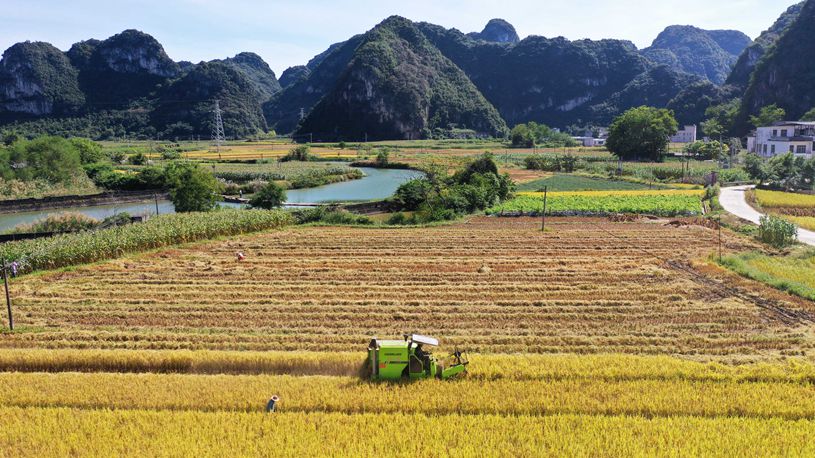*China's grain output is projected to hit a record high of 700 million tonnes this year, the Ministry of Agriculture and Rural Affairs said on Friday.
*The anticipated milestone harvest follows nine consecutive years of maintaining grain output above 650 million tonnes.
*Farmers attribute the hard-won bumper harvest to the combined effects of the authorities' swift actions in disaster relief, the continuous building of high-standard farmland, the promotion of modern and even smart farming, and the timely payment of agricultural insurance.
HARBIN, Oct. 26 (Xinhua) -- Harvesting is nearing completion in the major Chinese agricultural provinces of Heilongjiang, Henan and Hunan, with a bumper harvest of grain expected, despite extreme weather that caused multiple natural disasters, harming crop growth.
China's grain output is projected to hit a record high of 700 million tonnes this year, the Ministry of Agriculture and Rural Affairs said on Friday.
The anticipated milestone harvest follows nine consecutive years of maintaining grain output above 650 million tonnes, the ministry said at a press conference.
As of Thursday, northeast China's Heilongjiang Province, the country's top grain producer, had harvested more than 90 percent of its crops, or 220.9 million mu (about 14.7 million hectares) of planting area, according to the provincial department of agriculture and rural affairs.
The grain harvest included 50.7 million mu of rice, 90.1 million mu of corn and 72.8 million mu of soybeans. Meanwhile, harvesting has been completed for 1.2 million mu of miscellaneous grains and beans, and 473,000 mu of potatoes.
Harvesting is expected to be fully completed in the province before the end of this month.
Heilongjiang experienced a cold spell and lingering rainy weather from June to July this year, which hindered the growth of crops in many parts of the province.
Han Zhimin, who leads a grain planting cooperative in Yilan County, in the provincial capital of Harbin, said his cooperative planted 30,000 mu of corn and soybeans this year. Advanced farming techniques and modern farming practices helped him weather the disaster, while crop insurance saved him from financial worries.
"We have hired a full-time agronomist, using new technology and professional management to increase the soybean planting density while enhancing the crop quality," said Han, adding that the cooperative spent more than 10 million yuan (about 1.4 million U.S. dollars) in the past 10 years on purchasing modern farming machinery such as high-powered tractors, harvesters and high-speed precision planters.
From January to August, Heilongjiang had 171 million mu of grain growing area covered by crop insurance, up 4.27 percent year on year, with the insurance coverage rate in the province standing at 77.7 percent, according to data from the Heilongjiang branch of the National Financial Regulatory Administration.
The province also leads the country in building more than 110 million mu of high-standard farmland. Well-leveled, contiguous plots with advanced irrigation, efficient water use and enhanced soil fertility characterize high-standard farmland. Designed to withstand both droughts and floods, it aligns with modern agricultural practices and features pollution-free soils and high yields.
The province's grain output reached 77.88 billion kg in 2023, extending its hold on the number-one ranking in China for 14 consecutive years.
WEATHER WREAKING HAVOC
Chinese farmers have resisted various disasters to achieve the grain harvest, as the country has grappled with extreme weather events occurring with increasing frequency this year, featuring both relentless heat and heavy downpours.
Farmers attribute the hard-won bumper harvest to the combined effects of the authorities' swift actions in disaster relief, the continuous building of high-standard farmland, the promotion of modern and even smart farming, and the timely payment of agricultural insurance.
Shi Zejie, a farmer in Zhecheng County, central China's Henan Province, said that although his field is high-quality farmland, a severe drought in June deprived it of irrigation water. He hurried to hire more than 100 people to pump water into the field round-the-clock to rescue the seedlings on more than 4,000 mu of corn and more than 5,000 mu of sorghum.
In the middle of July, the same field was subjected to continuous heavy downpours, and Shi had to hire people for drainage work. Under the coordination of the local authority, more than 40 pumping engines were sent promptly to help save his plants.
According to the county's meteorological service monitoring, the average precipitation in Zhecheng reached 397 mm from July 15 to 18, while the county's annual precipitation in the past 30 years averaged 767 mm. Half of the annual precipitation occurred during just three days of extreme rainfall in July.
Shi has now harvested his corn, and the field's per-unit yield is 25 percent less than that of a normal year. However, he is satisfied with the hard-won results of the planting battle this year. Furthermore, the local authorities have helped farmers rebuild irrigation and drainage infrastructure following the disasters.
Shi recently received 100,000 yuan in insurance indemnity for his disaster-damaged corn field.
The rare rainfall resulted in crop failures in nearby Tanghe County, Henan. After the flood water receded, agricultural experts guided farmers in replanting mung beans, sweet potatoes, vegetables and other cash crops to compensate for the losses.
Qiao Zhenqun, who lost 100 mu of his 2,000 mu corn harvest this year, said the effect of the replanting was successful. The income from mung beans and sweet potatoes is expected to be slightly higher than from corn, based on the current market price.
Data from the Henan investigation group of the National Bureau of Statistics shows that Henan reaped a total summer grain output of 37.9 million tonnes, 6.64 percent higher than that of last year, safeguarding the province's role as the country's second-largest grain producer. Although its autumn grain fields suffered losses, harvesting will soon be completed on 76 million mu of crops. Henan's annual grain output is expected to remain stable at more than 65 billion kg.
Meanwhile, in central China's Hunan Province, Zhang Shunda, a veteran grain grower in Taoyuan County, in the city of Changde, has been busy harvesting rice in his 600-mu field these days. Foreseeing the harvest of more than 300,000 kg of rice, the farmer let out a sigh of relief.
It was a hard year for rice farmers in Hunan, as the province experienced a snowstorm at the beginning of the year and severe floods in summer.
"All three of my rice seedling greenhouses were toppled by the snowstorm in February, and 600 mu of early rice was inundated by floods in June," said Zhang.
The heavy rainfall caused severe damage to early rice growth in Taoyuan, the top grain grower in Hunan. The local authority promptly took measures to help farmers weather the disaster.
Zhang recalled that technicians dispatched by the county and township governments visited him to investigate the damage after the snow disaster and guided him on rebuilding and heating the warehouse to melt the snow. He has received 80,000 yuan of disaster relief subsidies and more than 300,000 yuan of policy subsidies for rice planting.
According to the Hunan provincial department of agriculture and rural affairs, grain production in the province remained sound this year. The harvesting of more than 22 million mu of middle-season rice in the province has been completed, with an estimated yield growth of about 1 percent year on year. Harvesting is nearing completion in more than 19 million mu of late rice fields, which can expect a yield increase of 1.5 percent year on year.
(Video reporters: Sun Xiaoyu, Jiang Liang; Video editors: Hong Yan, Luo Hui, Zhang Nan) ■












